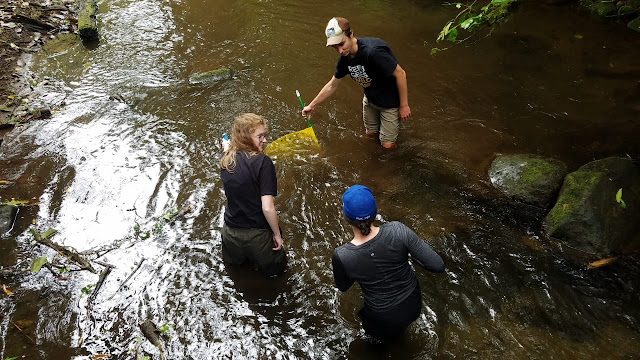Playing in the Water/Jugando en el aqua
Playing in the Water
Written by: Ryan Fawcett, ADE Watershed Coordinator/Researcher
Currently, ADE is hosting several students from across the United States and Canada through an educational program called STAM. STAM is an accelerated science course covering sustainability, tropical agriculture, and missions. Students study material and get hands-on experience, while they learn alongside us here in Costa Rica. Recently, the STAM students helped collect data from a local stream in San Rafael de Vara Blanca next to our organic farm.
I had the opportunity to not only teach, but also show the students how to collect scientific data on aquatic macroinvertebrates. I thought I got a lot of joy from hopping in the river until I saw the STAM students diving straight into the water (literally and figuratively). With their boots filled to the top with water, pants soaked to the waist, and hands dirty from digging around, we popped back out of the river and started picking the macroinvertebrates out of the net and into our containers. From there we were able to observe and identify the insects based on their family taxonomic rank. I was so encouraged after seeing the bright eyes and enthusiasm the students brought with them.
But, why is it important to look at aquatic macroinvertebrates? Aquatic macroinvertebrates, or insects, play a significant role in freshwater ecosystems. Water quality can be examined by observing the macroinvertebrate populations and by determining stream diversity you can compare different locations. Macroinvertebrates have specific niches for specific micro-environment, therefore collecting samples from multiple parts of the same section of stream is important. The substrate type, rate of water flow, amount of sunlight, depth, and more all influence where insects hide. Once a large sample size has been collected the river can be assessed easily by inputting raw data into indexes and calculating statistical test. But, why is it important to collect this data? Data collection helps put a quantitative number and demonstrate empirical evidence of a specific hypothesis or question. The data can then display the actual state of the streams rather than only using non-measured terms such as clean or dirty.
With this data and other data that has been collected, we hope to make a positive impact on the watersheds in Costa Rica. The STAM students were a huge help in aiding ADE to further our research in Costa Rica. I might have been the “teacher” in the river, but I think I learned more from the students than they learned from me!
Jugando en el agua
Escrito por: Ryan Fawcett, coordinador de cuencas/investigador de ADE
Actualmente, ADE está hospedando a varios estudiantes de los Estados Unidos y Canadá a través de un programa educativo llamado STAM. STAM es un curso acelerado de ciencias que cubre la sostenibilidad, la agricultura tropical y las misiones. Los estudiantes estudian material y obtienen experiencias prácticas, mientras aprenden con nosotros aquí en Costa Rica. Recientemente, los estudiantes de STAM nos ayudaron a recopilar datos de un flujo local en San Rafael de Vara Blanca al lado de nuestra granja orgánica.
Tuve la oportunidad no sólo a enseñar, sino también a mostrar a los estudiantes cómo recopilar datos científicos sobre los macroinvertebrados acuáticos. Pensé que me daba mucha alegría saltar al río hasta que vi a los estudiantes de STAM sumergiéndose directamente en el agua (literal y figurativamente). Con las botas llenas hasta el tope de agua, los pantalones empapados hasta la cintura y las manos sucias de excavar, salimos del río y comenzamos a recoger los insectos de la red y ponerlos en nuestros contenedores. Desde allí pudimos observar e identificar a los macroinvertebratos según su rango taxonómico familiar. Me sentí muy animada después de ver los ojos brillantes y el entusiasmo que los estudiantes trajeron con ellos.
Pero, ¿por qué es importante observar a los macroinvertebrados acuáticos? Los macroinvertebrados acuáticos, o insectos, juegan un papel importante en los ecosistemas de aguas frescas. La calidad del agua se puede examinar observando poblaciones de macroinvertebrados y después determinando la diversidad de arroyos puede comparar diferentes ubicaciones. Los macroinvertebrados tienen nichos específicos para microambientes específicos, por lo tanto, es importante recolectar muestras de varias partes de la misma sección de flujo. El tipo de sustrato, la velocidad del flujo de agua, la cantidad de luz solar, la profundidad y más influyen en el lugar donde se esconden los insectos. Una vez que se ha recolectado un gran tamaño de muestra, se puede evaluar al río fácilmente por manera de ingresar datos crudos en los índices y calculando la prueba estadística. Pero, ¿por qué es importante recopilar estos datos? La recopilación de datos ayuda a poner un número cuantitativo y demostrar evidencia empírica de una hipótesis o pregunta específica. Los datos pueden mostrar el estado real de los flujos en lugar de usar términos no medidos como limpio, sucio y algo sucio.
Con estos datos y otros datos que se han recopilado, esperamos tener un impacto positivo en las cuencas hidrográficas. Los estudiantes de STAM fueron de gran ayuda para ayudar a ADE a promover nuestra investigación en Costa Rica. Podría ser el "maestro" en el río, ¡pero creo que aprendí más de los estudiantes de lo que ellos aprendieron de mí!





Comments
Post a Comment